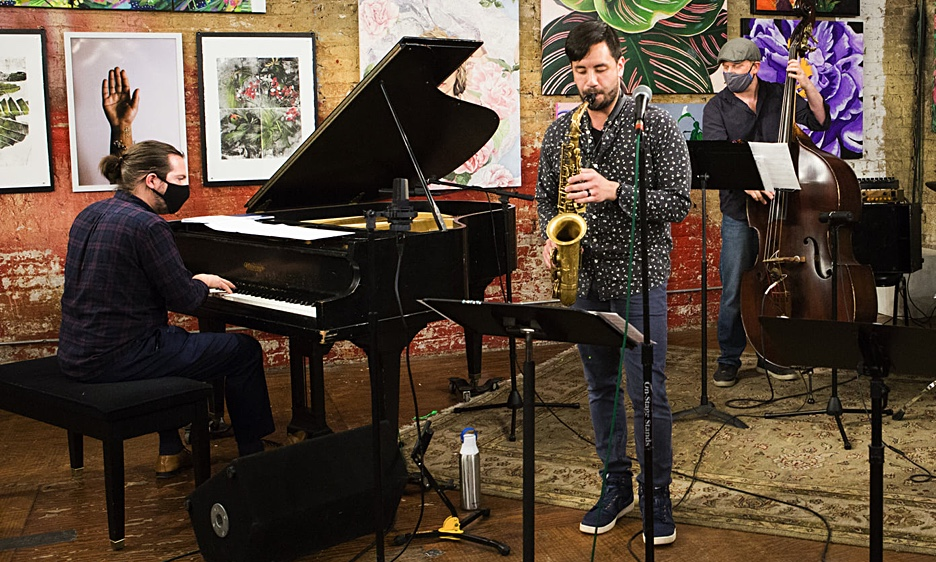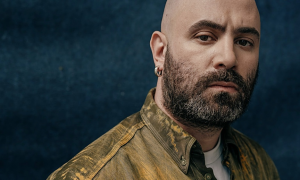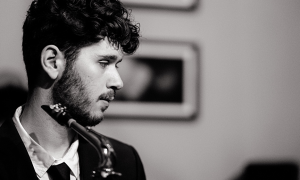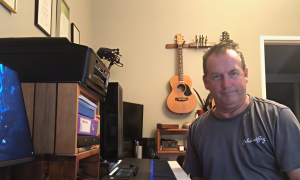Home » Jazz Articles » Take Five With... » Take Five with Matthew Muñeses
Take Five with Matthew Muñeses

Courtesy Janet M. Takayana
Meet Matthew Muñeses
Matthew Muñeses is a saxophonist and educator residing in the northwest suburbs of Chicago. In 2011, he received his B.M. in Saxophone Performance at Illinois State University and his M.M. in Jazz Performance at the University of Illinois at Urbana-Champaign in 2013. During this time, Matthew studied with Dana Hall, Chip McNeill, Ron Bridgewater, Tito Carrillo, and Chip Stephens.In the subsequent years, Matthew has garnered recognition as an up-and-coming talent by winning or being named as a finalist in multiple educational and open competitions, including the Jazz Society of the Philippines competition and the Kate Neal Kinley Memorial Fellowship. In 2015, Matthew participated in a workshop with Steve Coleman and Five Elements at the University of Chicago where he was afforded the opportunity to study with and perform alongside Coleman, Jonathan Finlayson and Miles Okazaki. Today, Matthew teaches saxophone technique, jazz improvisation and composition through his private studio and in-residence at St. Charles North and South Elgin High Schools. He has given masterclasses at Illinois State University, the University of Northern Iowa, Northern Illinois University, and Northwestern University. His sophomore album, Noli Me Tángere was released in June 2022 by Next Level, an imprint of Outside in Music.
Instruments
Saxophone.I mainly play alto and tenor—since I'm happily a P. Mauriat artist, I play a Master 97 alto and a System 76 tenor, both unlacquered.Teachers and/or influences?
I have had a number of teachers over the years, and all have been important in shaping my musical identity, but specifically some teachers from my master's degree studies—Tito Carrillo, Dana Hall, and Chip McNeill. Dana is also on my new record. The education I got from him is part of the reason why I wanted to work with him in my professional life.In terms of musical influences as a listener, writer, and player—my biggest influences are Miguel Zenon, Jon Irabagon (both of them were involved with this recording), Fabian Almazan, John Coltrane, Joe Henderson, and Ambrose Akinmusire.
Miguel and Jon specifically have been hugely important to me in terms of mentorship and playing—I've been borderline obsessed with their respective musics for almost 15 years. I got hip to Miguel through my sax professor in undergrad, Dr. Paul Nolen; Miguel had just released Awake (Decca / Marsalis Music, 2008), and Dr. Nolen knew I would dig it, but I wasn't expecting to have my life changed! I've been obsessed since. Jon I found out about because of the Monk Competition, and the fact that he was also Filipino was huge to me. I finally had someone that came from the same background and did what I was trying to do. Since I reached out to him, he's been a great friend and mentor to me, and I'm extremely appreciative of that.
I knew I wanted to be a musician when...
I knew I wanted to be a musician when I was 13 and my grandmother had me listen to the soundtrack to Arturo Sandoval's biopic. I heard this interview he did for that movie, and he mentioned the reason he played. It was something to the effect of, If God gives you a gift for playing music, you have to do it. Nothing can stop you, not even Castro. That really hit me, because I grew up thinking I was supposed to be a doctor, but this made me realize I had to follow the spirit and do it.Your sound and approach to music.
I draw a lot of my sound concept from two players I've already mentioned—Miguel and Jon. I also draw from the alto tradition—Dick Oatts, Eric Dolphy, and Bird. In terms of my approach to playing, I try to be as relaxed and in the moment as possible. I'm always trying to connect with the other musicians to make as united and powerful of a statement as we can [so that] we can start to tap into something beyond ourselves.Your teaching approach
Firstly— love teaching—the gratification of helping students realize their goals and ambitions, or helping them learn lessons that they can carry through life, even if they don't pursue music professionally, is deeply moving to me.I try to balance the essential pedagogy with things the students really engage with. Whether that means connecting musical concepts to sports, or letting them learn songs from the newest Disney movie, I try to make sure they're living the joy of music while still learning the fundamentals.
Your dream band
My dream band is basically the band I have on this new record—I've looked up to those musicians for most of my musical career, and playing with this group of people has been such an enlightening experience. If I had to go into historical mode, though, I'd say my dream band would include Elvin Jones, McCoy Tyner and Jimmy Garrison. That fire and energy are what I'm always looking for in my music, even though the aesthetic is somewhat different. In terms of modern musicians that I'd love to play my music with, I'd also love to hear what Fabian Almazan, Linda May Han Oh and my friend Jay Sawyer would do with it.Road story: Your best or worst experience
I just remember a food story from the first short tour I led. It was the first semester after I had finished my master's and was doing a quick run through cities and towns in central Illinois and Chicago. One morning we had breakfast at a kind of shifty diner before a series of masterclasses at my high school, and the whole rest of the day, our stomachs were just toast. It was truly a relief when we were done for the day and could go sleep it off. Nothing more needs to be said!Favorite venue
My favorite room so far has been Constellation in Chicago—I just played there for the first time during the release tour, and it felt just as intimate as I always feel when I'm listening to shows there. I love the mix of a big room that feels close.Your favorite recording in your discography and why?
Haha! My discography is pretty limited thus far, and my new record means so much to me on so many levels, so Noli Me Tángere gets the nod here. It was a long time coming, and I was able to make it happen with my heroes. So it was exactly what I wanted and needed in this moment. That being said, I'm looking forward to getting to work on the next few records I'll do, where I'll be exploring other Filipino music such as tinikling (Filipino folk dances), and kulintang ensembles (pitched percussion/gongs).What do you think is the most important thing you are contributing musically?
Over the past couple years, Jon and I have been talking about our purpose as Filipino jazz musicians and how it's incumbent on us to put out music with integrity and make the most out of our opportunities so that the next generations of Filipino musicians have an easier path to making it in this world [and] so that they're taken more seriously by booking agents and creative directors for festivals, and not just marginalized because a Filipino jazz musician won't sell, or isn't "relatable."For that reason, I'm hoping that my music introduces people to a unique culture, and encourages them to explore music from other parts of the world. The Philippines has such a rich and deep cultural tradition, and it just doesn't get the notice I feel it deserves. I hope this helps.
Did you know...
Not sure what to put here—there's simultaneously much and little to say. I'm devoted to my family, and I'm an avid amateur tennis player. I don't do too much else! The first jazz album I bought was:
Arturo Sandoval's Swingin' (GRP, 1996). This was also my intro to Michael Brecker. Fifteen-year-old me was like, "What the hell is happening? This guy sounds insane!" And so, I had a new obsession.Desert Island picks:
Miguel Zenón: Identities Are Changeable (self-released, 2014)John Coltrane: A Love Supreme (Impulse!, 1965)
Fabian Almazan: Alcanza (Biophilia Records, 2017)
Jon Irabagon: Behind the Sky (Irabbagast Records, 2015)
Michael Jackson: Dangerous (Epic Records, 1991)
Kendrick Lamar: untitled unmastered. (Aftermath, 2015)
Stevie Wonder: Talking Book (Motown Records, 1972)
How would you describe the state of jazz today?
I think it's a pretty amazing time to be part of the community. There are so many great musicians and it's easy to hear much of their work. Truthfully, it's both inspiring and intimidating at times. Obviously there's a marketing problem for improvised music, but I feel like quality, honest music speaks to people and gets the attention of the people it needs to.What is in the near future?
I am excited to finally reconnect with much of my family and friend group now that my youngest child is finally able to be vaccinated and therefore protected against COVID. Musically, I want to explore this music more with the band, hopefully do another few stretches in the later summer and fall. The trumpeter on this record, Zubin Edalji, is recording his debut record this fall, also, so we're gearing up for that and excited to share that. Then, pick an avenue, and start working on that next record.What is your greatest fear when you perform?
Not accurately conveying my intentions.What song would you like played at your funeral?
"On Eagle's Wings"What is your favorite song to whistle or sing in the shower?
Whatever is stuck in my head—usually what I've been listening to a lot at that time.If I weren't a jazz musician, I would be a:
I'd try to be a tennis or boxing coach. Or maybe a standup comedian? An etymologist? Not sure. Lots of paths!If I could have dinner with anyone from history, who would it be and why?
I mean, I have dinner with those people every day! But outside of them, I really just wish I could have one more meal with my Lolo and Lola. Since they lived in the Philippines, I only saw them a few times before they passed away, and I wish I could share my journey with them, and for them to see my beautiful family.Tags
Take Five With...
Matthew Muneses
AAJ Staff
Lydia Liebman Promotions
Dana Hall
Chip McNeill
Ron Bridgewater
Tito Carrillo
Chip Stephens
Steve Coleman
Miles Okazaki
Miguel Zenon
Jon Irabagon
Fabian Almazan
John Coltrane
Joe Henderson
ambrose akinmusire
arturo sandoval
Dick Oatts
Eric Dolphy
Elvin Jones
McCoy Tyner
Jimmy Garrison
Jay Sawyer
Constellation
Michael Brecker
Stevie Wonder
PREVIOUS / NEXT
Support All About Jazz
 All About Jazz has been a pillar of jazz since 1995, championing it as an art form and, more importantly, supporting the musicians who make it. Our enduring commitment has made "AAJ" one of the most culturally important websites of its kind, read by hundreds of thousands of fans, musicians and industry figures every month.
All About Jazz has been a pillar of jazz since 1995, championing it as an art form and, more importantly, supporting the musicians who make it. Our enduring commitment has made "AAJ" one of the most culturally important websites of its kind, read by hundreds of thousands of fans, musicians and industry figures every month.

























